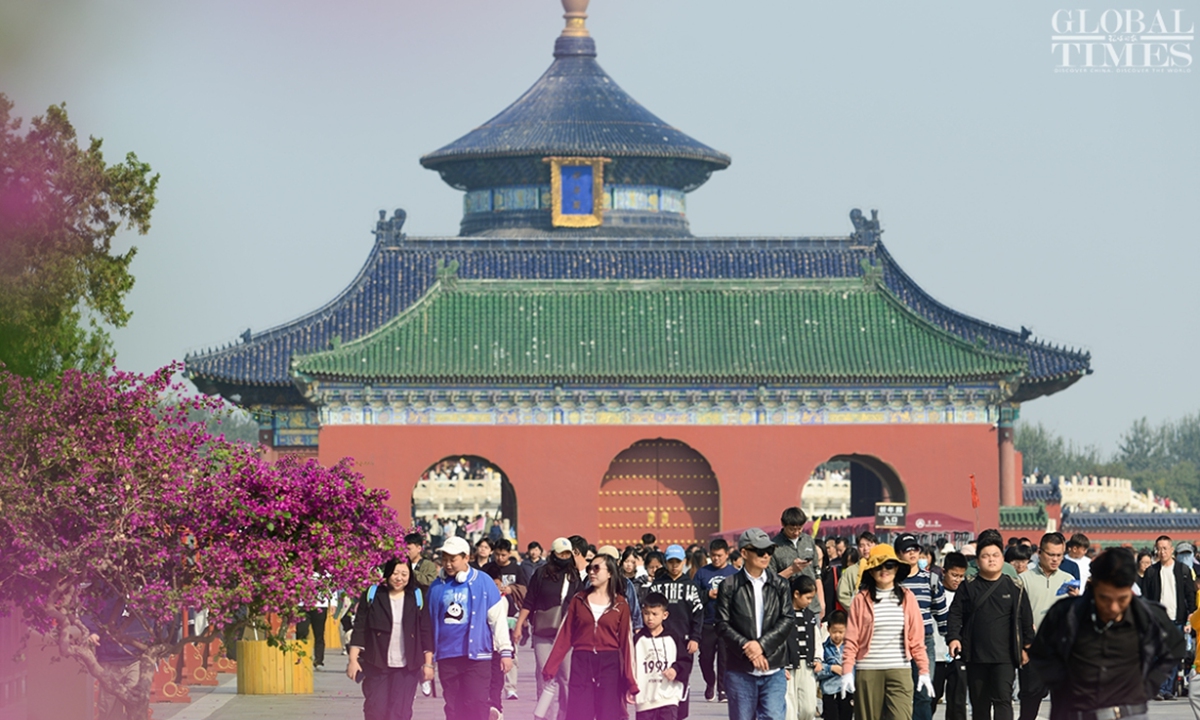
As of October 5, halfway through the National Day holidays, Beijing's parks continue to welcome large numbers of visitors. Photo: Chen Tao/GT
As China celebrates its National Day with seven-day holidays, the country is experiencing a surge in activity and economic vitality. These holidays provide an opportunity for the Chinese people to travel, shop, and celebrate, highlighting China's social, cultural, and economic diversity.
Over the past few years, Washington has, on the one hand, focused on the narrative of "China's economic collapse," a notion propagated by various high-ranking officials. They have repeatedly amplified this idea to the point of near hysteria. On the other hand, they have exaggerated the impact of the Chinese economy on the US, hyping up the so-called "second shock" that China could inflict on the US market through its manufacturing sector. The US strategy toward China is evolving into a full-blown "economic war" aimed at completely containing and suppressing China's development.
Can Washington's strategy succeed against a massive and dynamic economy like China's? Data from this year's National Day celebrations can help answer that question.
During this year's National Day holidays, China's traffic flow generally demonstrated a high level of operation. The average daily flow on highways is expected to be about 61-62 million vehicles, representing an increase of one to three percent over the same period in 2023. International flight bookings have doubled from last year, with Chinese tourists visiting nearly 1,600 cities across 144 countries and regions. These numbers are impressive by any standard.
However, it would be a mistake to judge China's economy solely based on holiday tourism. The thriving travel industry offers just a glimpse into China's diverse economic landscape.
One important question is how China's transportation system manages such massive human movement. Few countries have this capability.
It's not just about infrastructure, but also about economic scale, capacity, and the aspirations of the people. Ignoring these facts could lead to misjudgments about China's strength.
The National Day travel boom reflects rising disposable income, improved transportation, and a growing demand for a high-quality life. It also highlights a robust manufacturing sector, extensive road networks, and an innovative catering industry. Together, these elements paint a comprehensive picture of China's economy.
The 2024 Global Economic Diversification Index ranks China second globally in economic diversity, just behind the US.
This diverse economic structure is not easily constrained, demonstrating its resilience. Its strength lies in its multifaceted nature, which forms the foundation for developing new quality productivity in China.
Admittedly, China's economy is still undergoing one of the most challenging transformations in its development process. The rise of the stock market before National Day and the tourism boom during the holidays won't suddenly complete this transformation. Improving the overall economic fundamentals still requires a gradual process of policy implementation and execution.
Only by gaining a deeper understanding of the fundamental aspects of the Chinese economy - its scale, potential, and diverse society and culture - can one make accurate judgments and avoid using the narrative of "an impending economic collapse" as the basis for policy decisions. This deeper understanding will illuminate the complexity and resilience of China's economy.
US' attempts to limit China's development through restrictions on the high-tech industry won't be effective. While high-tech sectors are essential, China's economic foundation lies in its comprehensive manufacturing sector, world-class infrastructure, robust supply chains, and the diverse consumption patterns of its 1.4 billion people.
China's economy is like the Yangtze River; it draws strength from many sources. Its power comes not from a single industry but from the overall strength brought by diverse development. This diversity is evident in the industrial structure and the shared vision of 1.4 billion people seeking a better life. This forms the basis of China's economic confidence and is a force that no containment policy can easily obstruct.
Washington's strategy toward China reflects a misunderstanding of what drives China's economic development. If US policymakers thoroughly experienced China's economic vitality and understood that this is the rise of an emerging power distinct from American culture, they would reconsider their approach. Unfortunately, these decision-makers, influenced by a Western worldview, still fail to grasp the essence of China's rise.




